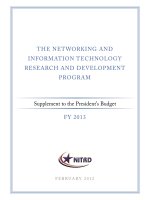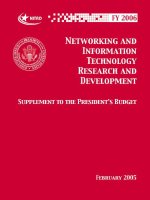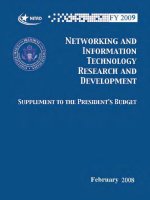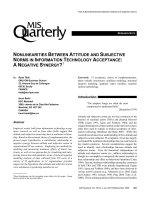information technology assignment 1 unit networking
Bạn đang xem bản rút gọn của tài liệu. Xem và tải ngay bản đầy đủ của tài liệu tại đây (1.33 MB, 41 trang )
<span class="text_page_counter">Trang 1</span><div class="page_container" data-page="1">
<b> </b>
<b>BTEC FPT INTERNATIONAL COLLEGE</b>
<b>INFORMATION TECHNOLOGYASSIGNMENT 1</b>
</div><span class="text_page_counter">Trang 2</span><div class="page_container" data-page="2"><b> ASSIGNMENT 1 FRONT SHEET</b>
<b>QualificationBTEC Level 4 HND Diploma in Business</b><b>Unit number and titleUnit: Programming</b>
<b>Submission date 22/07/2022<sup>Date received (1st </sup></b>
<b>Re-submission date 29/07/2022<sup>Date received (2nd </sup></b>
<b>Student declaration</b>
I certify that the assignment submission is entirely my own work and I fully understand the quences of plagiarism. I understand that making a false declaration is a form of malpractice.
<b>conse-Student’s signature: Nguyen Trinh Anh TuanGrading grid</b>
</div><span class="text_page_counter">Trang 3</span><div class="page_container" data-page="3"><b>Summative Feedbacks: Resubmission Feedbacks:</b>
<b>Internal Verifier’s Comments:</b>
<b>Signature & Date:</b>
i
</div><span class="text_page_counter">Trang 4</span><div class="page_container" data-page="4">1.2 Network type (MAN, WAN,LAN etc.)...8
1.3 Benefit of the network...10
1.4 Protocol and Standards...11
1.5 List some protocols : TCP/IP, HTTP,DNS,ICMP...15
1.6 List some standard organnizations and standard names...17
II. (P2)Network topology & communication and Bandwidth requirement...18
1 Network topology definition...18
2. Discuss the Impact of topology...18
3. Examples of topology with diagrams (Bus, Ring, Star, Tree, Hybrid, Mesh)...19
4.Communication and Bandwidth...21
5.Define Communications In Terms Of Networking...21
3.Other commonly used networking devices...24
4.List server types (web server, mail server, DB Serve, DNS Server, DHCP Server). 28IV.(P4) Discuss the inter-dependence of workstation hardware with relevant networking software...31
1.Explain What Is Meant By Interdependencies...31
2.Define networking software...32
3.Discuss and explain the interdepencies of workstation hardware with networking ware. Derive an example form your discussion...33
soft-IV. (M1) Compare common networking principles and how protocols enable the fectiveness of networked systems...33
</div><span class="text_page_counter">Trang 5</span><div class="page_container" data-page="5"><b> LIST OF TABLES AND FIGURES</b>
Figure 1 Define Network...6
iii
</div><span class="text_page_counter">Trang 6</span><div class="page_container" data-page="6"><b>LIST OF ACRONYM</b>
ACL Access Control List
ADSL Asymmetric Digital Subscriber Line ARCNET Attached Resource Computer Network ARP Address Resolution Protocol Bit Binary Digit
DHCP Dynamic Host Configuration Protocol DHCS Dynamic Host Configuration Server DNS Domain Name System
</div><span class="text_page_counter">Trang 7</span><div class="page_container" data-page="7">The report includes the following:
Chapter 1. Examine networking principles and their protocols. (LO1)
1 Discuss the benefits and constraints of different network types and standards. (P1)2 Network topology & communication and Bandwidth requirements. (P2)
CHAPTER 2: Explain networking devices and operations. (LO2)
3 Discuss the operating principles of networking devices and server types. (P3)
4 Discuss the inter-dependence of workstation hardware with relevant networking software. (P4)5 Compare common networking principles and how protocols enable the effectiveness of networkedsystems. (M1)
</div><span class="text_page_counter">Trang 8</span><div class="page_container" data-page="8">CHAPTER 1: BASIC KNOWLEDGE LO1: Examine networking principles and their protocols
I. (P1) Discuss the benefits and constraints of different network typesand standards.
1. What is network?1.1 Define network.
-A network could be a system consisting of many computers (at least 2 computers within the samesystem) that are connected to every other through physical transmission lines in line with a particular structure.
-The function of a network is to form data exchange and resource sharing between computers within the system easier without using external devices like USB, memory cards, and disks. CD…
-A complete electronic network system will include the subsequent parts: Terminals, transmissionmedium, physical connection equipment, and connection software.
-Terminals: Computers, phones, printers, scanners, cameras, etc. are all terminals in an exceedingly network. These devices are going to be connected to every other through connecting devices or transmission mediums.-Physical connection devices are devices like wires, modules, switches, etc., that are directly connected from one terminal to a different one.
-Connection software: kind of like the transmission medium, connection software is the program and application installed on the terminal devices and has the function of sharing data over wireless transmission lines.
-There are four common styles of computer networks today: LAN, MAN, WAN, and PAN. Below, we are going toshare thoroughly each kind of network.
-Metropolitan Area Network (MAN Network)-Wide Area Network (WAN Network)-Local Area Network (LAN Network)
<small>Figure 1 Define Network</small>
Client
</div><span class="text_page_counter">Trang 9</span><div class="page_container" data-page="9">-The client-server model (client-server network model) is a distributed application architecture. It partitions tasks or workloads between resource or service providers, called servers, and service requesters (Clients). In the Client-Server architecture, when the Client sends a request for data to the server over the Internet, the server accepts the requested process. Then send the requested data packets back to the client. Clients do not share any of their resources.
-When it comes to Client, it means a person or an organization that uses a particular service. The same is true in the digital world. Client is a computer (Host), ie capable of receiving information or using a specific service from service providers (Server).
Peer to peer (P2P)
-A peer to peer (P2P) network is a distributed application architecture that partitions tasks or workloads among peers. Peers are devices participating in the application with equal privileges. They form a peerto-peer network of nodes.
-Peers make a portion of their resources, such as processing power, disk storage, or network bandwidth, available to other participants without the need for central coordination of a stable server or host. Peers are both providers and consumers of resources. It differs from the traditional client-server model in that resource consumption and provision are split.
-Previously, the peer-to-peer system was used in many application areas. This architecture waspopularized by the file sharing system Napster, released in 1999. This concept has inspired newstructures and philosophies in many areas of human interaction. In such a social context, peer-to-peer as a meme refers to the egalitarian social network that has emerged throughout society, enabled by Internet technology in general.
</div><span class="text_page_counter">Trang 10</span><div class="page_container" data-page="10">1.2 Network type (MAN, WAN,LAN etc.)LAN
-LAN stands for Local Area Network, roughly translated as local computer network, this interface allows computers to connect to each other to work together and share data. This connection is made via a LAN cable or Wifi (wireless) in a narrow space, so it can only be used in a limited range such as offices, homes, schools...-LAN has great significance in today's modern life, any company, organization or individual who wants to manage internal data, or connect and communicate with each other must be through LAN. LAN helps mobile devices such as phones, laptops, tablets easily connect and access the internet at any time
Benifit-High speed.
-Can run large online applications thanks to strong bandwidth-Cheap and easy to manage
</div><span class="text_page_counter">Trang 11</span><div class="page_container" data-page="11">departments connected to each other.
Man network is often used for businesses because this model provides many types of services such as connecting lines via voice (voice), data (data), video (image), and deploying applications easily. - Advantages of MAN network. The large connection range makes the interaction between business parts easy, efficient, low cost, stable transmission speed, information security, and simple management.Benefit:
Can connect with high speed up to 1Gb/s to run the state, change information, develop ecommerce.Popular with large bandwidth needs in big cities like Hanoi and Ho Chi Minh City
-There is a wide variety of services, maximized on modern bandwidth, service by providing service in the present and in the future, improving the broadband network service will be highly profitable network.Constaint:
Complex managementHigh cost
The connection is quite large
Have average bandwidth to run banking operations
</div><span class="text_page_counter">Trang 12</span><div class="page_container" data-page="12">Weak connection because of low bandwidth.High installation cost.
Difficult to manage.
1.3 Benefit of the network
-The Internet is extremely important and brings a lot of benefits to the entire global humanity. The Internet makes information transfer quickly, you can access information on the internet at almost any location on the globe. For the sake of simplicity, to summarize the internet has the following benefits:
-Look up and learn a huge store of information online
-Help people do business, sell online, make money and increase jobs
-Linking friends and relatives through social networks like Facebook, vegetable garden Zalo-Send and receive mail, read online news
-Watch movies, listen to music online, play games-Using social networking apps…
1.4 Protocol and Standards Network Protocol Definition
The protocol is a rule file that defines how to format, transmit, and receive data so that network computers from servers and routers to endpoints - can communicate with each other, regardless of any differences in the base layer, design, or standard facilities. To send and receive data successfully, devices on both sides of a communication exchange must accept and follow protocol conventions.
</div><span class="text_page_counter">Trang 13</span><div class="page_container" data-page="13">--Network protocol support can be built into the software, hardware, or both. Standardized network protocolsprovide network devices with a common language. Without them, computers would be unable to communicate with one another. As a result, except for networks explicitly designed for a specific architecture, only a few networks can function, and the internet as we know it today would not exist. To communicate with one another, almost all end-users rely on network protocols.
Network Protocol Definition
-Internet Protocol Suite is also referred to as Internet Protocol Suite. This protocol may be a collection of protocols that implement the protocol stack on which the web runs.
-This protocol also can be called TCP/IP protocol. they're all important protocols within the Internet Protocol Suite. TCP - Transmission Control Protocol and IP - Internet Protocol. And it can even be understood that Internet Protocol Suite is analogous to the OSI model, but there are differences between them, but not precisely the same. In layers (layers), not all layers correspond well.
Protocol Stack
-Protocol Stack may be a kind of software implementation for a group of network protocols. they're a full set of protocol layers that they work together to supply network connectivity to other devices.
Transmission Control Protocol (TCP)
-Transmission Control Protocol (TCP) could be a transport control protocol. they're the core protocols of the net Protocol Suite. With the task of implementing the network, complement the net Protocol. This protocol ensures reliable and in-order delivery of information to the destination. TCP also provides a way for reliably delivering an octet stream. As an 8-bit data block stream, TCP also distinguishes between data from many various applications.
File Transfer Protocol (FTP)
-File Transfer Protocol (FTP) – File transfer protocol. and therefore the direction won't be to exchange files over a communication network using the TCP/IP protocol. FTP's default port is 20/21.
Secure Shell (SSH) Network Protocol
-Secure Shell (SSH) could be a network protocol wont to securely establish network connections. SSH operates on the upper layer of the TCP/IP layered model. It will be said that SSH is the main method accustomed to securely managing network devices at the command level. it absolutely was replaced by Telnet thanks to its greater security. SSH's default port is 22.
Internet Protocol (IP)
-Internet Protocol (IP) is additionally called Internet protocols and they are the most protocols within the Internet protocol suite. With the power to forward data over the network and help establish the web through routing of Internet Protocol. IP provides an unsecured data delivery service so a knowledge packet may arrive intact, it should arrive out of order. IP is extremely common on today's internet. the foremost common network layer protocol today is IPv4 or IPv6.
Hypertext Transfer Protocol (HTTP)
</div><span class="text_page_counter">Trang 14</span><div class="page_container" data-page="14">-Hypertext Transfer Protocol (HTTP) – Hypertext Transfer Protocol. they're one among the five standard protocols of the web. This protocol is employed to speak information between the service provider (The web server) and also the service user (The web client). They add the Client/Server model for the globe Wide Web (www).
Domain Name System (DNS) network protocol
-Domain Name System (DNS) - name resolution system. this technique could be a system that permits the determination of correspondence between IP address and name on the net. because of this protocol, it's possible to convert domain names to IP addresses. The default DNS port is 53.
Post Office Protocol version 3 (POP 3)
-Post Office Protocol version 3 (POP3) is an application layer protocol, accustomed retrieve email messages from mail servers, over a TCP/IP connection. In version 3 this enables the client to urge the whole content from the server's mailbox and delete the content from that server. The default POP3 port is 110 and therefore the secure POP3 port is 995.
Internet Message Access Protocol (IMAP)
-The Internet Message Access Protocol (IMAP) is a web standard protocol utilized by email clients to retrieve email messages from mail servers over a TCP/IP connection. IMAP doesn't remove content from the server's mailbox. The default IMAP port is 143 and therefore the secure IMAP port is 993.
Hypertext Transfer Protocol over SSL/TLS (HTTPS)
-Hypertext Transfer Protocol over SSL/TLS (HTTPS) may be a combination of the HTTP protocol and therefore the SSL or TLS security protocol that enables the secure exchange of knowledge on the net. The default port of HTTPS is 443.
Simple Network Management Protocol (SNMP)
-Simple Network Management Protocol (SNMP) may be a set of protocols that not only allows testing of network devices like routers, switches, servers, etc. but also supports the optimal operation of those devices.The function of SNMP is to observe, configure and control network devices remotely. SNMP traps may also be configured on network devices to notify when specific activity occurs. The default port of SNMP is 161/162.
Telnet network protocol
-Telnet (Terminal Network) is the main method accustomed manage network devices at the command level. Or they're used on connections to the web or connections at a neighborhood area network LAN. Telnet's default port is 23.
Simple Mail Transfer Protocol (SMTP)
-Simple Mail Transfer Protocol (SMTP) - a straightforward mail transfer protocol, could be a standard for transferring email messages over the web. they need the most function
</div><span class="text_page_counter">Trang 15</span><div class="page_container" data-page="15">1. The protocol is a rule file that fines how to format, transmit, and receive data so that network
de-2. computers - from servers and routers to endpoints - can commu-nicate with each other, regardless ofany
3. differences in the base layer, sign, or standard facilities.
</div><span class="text_page_counter">Trang 16</span><div class="page_container" data-page="16">ac-6. and follow protocol conventions. Network protocol support can be built into the software, hardware, or7. both.
8.
9. Standardized network protocols provide network devices with a common language. Without them, 10. computers would be unable to
communicate with one another. As a result, except for networks explic-itly
11. designed for a specific ture, only a few networks can func-tion, and the internet as we know it
</div><span class="text_page_counter">Trang 17</span><div class="page_container" data-page="17">architec-12. today would not exist. To municate with one another, almost all end-users rely on network
com-13. protocols.
14. The protocol is a rule file that fines how to format, transmit, and receive data so that network
de-15. computers - from servers and routers to endpoints - can commu-nicate with each other, regardless ofany
16. differences in the base layer, sign, or standard facilities.
de-17.
18. To send and receive data fully, devices on both sides of a
</div><span class="text_page_counter">Trang 18</span><div class="page_container" data-page="18">success-communication exchange must cept
ac-19. and follow protocol conventions. Network protocol support can be built into the software, hardware, or20. both.
21.
22. Standardized network protocols provide network devices with a common language. Without them, 23. computers would be unable to
communicate with one another. As a result, except for networks explic-itly
</div><span class="text_page_counter">Trang 19</span><div class="page_container" data-page="19">24. designed for a specific ture, only a few networks can func-tion, and the internet as we know it 25. today would not exist. To com-
architec-municate with one another, almost all end-users rely on network
26. protocols.
Protocol
-A protocol is a set of established rules that define how to format, transmit, and receive data so that computer network devices - from servers and routers to endpoints can communicate with each other, regardless of the differences in infrastructure, design, or basic standards between them.
</div><span class="text_page_counter">Trang 20</span><div class="page_container" data-page="20">Network protocol definition
-A network protocol is a set of rules that a network must follow. Network protocols are formal standards and policies made up of rules, procedures, and formats that define communication between two or more devices overa network.
</div>








